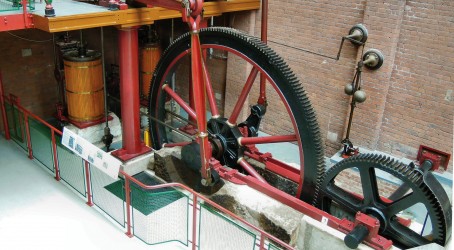Museums
During the Industrial Revolution, Bolton was one of the largest and most productive cotton-spinning centres in the world. Hundreds of busy mills across the Lancashire region employed thousands of workers.
Around 10,000 locally built steam engines powered the spinning and weaving machinery in the mills, which produced more than half the world’s entire supply of cotton textiles.
But the cotton industry began to decline sharply after the First World War, and by the 1980s textile manufacturing had almost ceased in the region.
Fortunately, in the 1960s a small group of local enthusiasts decided to take action and preserve the different types of engines that once powered this booming industry. Over many years the group acquired and reassembled several different engines, putting them on show to the public for the first time in 1983.
Today, the museum is housed in a former Atlas Mills cotton warehouse, where a collection of 27 engines – the largest in the country – can be seen and heard. Visitors are invited to meander around the great machines that were once the backbone of the Industrial Revolution.
When you enter the museum, two giant beam engines catch your eye. The Crossfield Mill beam engine, which comes from a textile mill in Wardle, is one of the oldest machines in the collection, dating back to 1840.

Also in the warehouse is the Kenyon engine, a giant vertical cross-compound device which was bought by the society when it was threatened with scrapping. This beam engine has some unusual features, including a special “trip gear” that was patented by James Lumb in 1892.
Nearby, a magnificent McNaughted beam engine from around 1870 can be seen. This giant was widely used in the industry until it was superseded by the more modern horizontal engine design.
One of the more recent additions to the collection is an inverted vertical compound engine, which came from Hardman and Ingham’s Diamond Rope Works at Royton. Nicknamed “Lily”, this engine was built in 1914 and used for almost 60 years until a fire badly damaged the mill in which it was housed. It takes up surprisingly little floor space, which in its day made it an appealing choice for customers looking to replace an existing engine, or buy an additional one.
Also preserved at the museum is the only known surviving example of a Musgrave non-dead-centre engine. This stationary steam engine was designed to solve the problem of stopping dead centre by using two cylinders, additional connecting rod linkages and geometry.
Several other oil and gas engines, boilers and pumps form part of this niche collection. To see the engines in their full glory, it’s worth visiting the museum on one of the steam open days, which are held throughout the year.